
The Land of Fire
The weather was getting colder as the sun started to go down. We had a very clear sense of how far south of the equator we are now. We make the decision to ride to Rio Gallegos as we know we can make it and we also know that once we do we’ll find fuel.
The small city was founded as a navel port and has a strong military history. It was from here that the ill-fated Belgrano sailed to Las Malvinas (as the Falklands are known in Argentina) in 1982. Many of the streets are now named after heroes of the conflict.
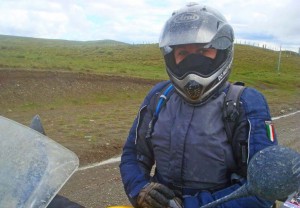 As we ride into the town we find that the residents are marking the 25th anniversary of the war. Cars and trucks bear stickers and banners proclaiming “25 anõs”. We ride down the main street and find ourselves a cheap but clean motel for the night, chosen as usual for its secure parking for the bikes.
As we ride into the town we find that the residents are marking the 25th anniversary of the war. Cars and trucks bear stickers and banners proclaiming “25 anõs”. We ride down the main street and find ourselves a cheap but clean motel for the night, chosen as usual for its secure parking for the bikes.
It’s a strange day. We are one day’s ride from ‘the end of the world’ and all things being equal we’ll be in Ushuia tomorrow evening. All along this journey we’ve always been careful to let each other know that we can bail out and fly home at any time. At times this has seemed like it might have to happen. And yet, here we are just about to complete a road trip from one end of the Americas to the other. The bikes, which are now less than eight months old, have a little over 45,000 kilometres on the clocks and we’ll be changing the tyres for the fifth time in the next few weeks.
We never thought that we could get this madness off the ground, how could we finance and organise such an epic trip? We seem to be about to muddle through!
So it’s with mixed emotions that we get some food, check our kit and fill the bikes – as well as every fuel container we can carry – with precious petrol before returning to the motel and getting a good night’s sleep.
The following morning we ride out of town and back onto the southbound Ruta 3. The road is anonymous and boring, it doesn’t have so much as a corner. The landscape is featureless and typically Patagonian. One hundred and forty brisk kilometres later we reach the first border crossing from Argentina into Chile at Paso Integración.
Down here the road crosses the border several times and we’ll have to present ourselves at several crossings during the day.
 The border crossing was quick and efficient on both sides. We were now back in Chile and on the same road with a Chilean designation; Ruta 255. We rode to Punte Delgada and Primera Angostura before arriving at the Magellan Straits.
The border crossing was quick and efficient on both sides. We were now back in Chile and on the same road with a Chilean designation; Ruta 255. We rode to Punte Delgada and Primera Angostura before arriving at the Magellan Straits.
For the first time we get a sense of where all this Patagonian wind is coming from. It seems to be coming over the water from four different directions. The chop on the strait is pretty busy and the swell is high enough to give us pause before we get on the ferry.
The ferry is a really simple roll on roll off affair.
As we sat on the simple concrete ramp that ran down to the water the ferry ‘docked’ by sailing to the dock and dropping the front gate onto the concrete. The boat was like a larger version of a Normandy landing craft from WWII. There was a gate on each of the deck, a high bulkhead on each side and the bridge was built, quite literally, on a bridge, which ran across the whole structure and was tall enough to fit an articulated truck under.
The staff then instructed the traffic, most of it heavy goods vehicles, to drive off. The crew on the boat then fought with the pull of the water as the waves seemed to want to pull it out to the Pacific.
As we started to load, we watched the waves hit the ferry and throw water onto the loading ramp. This made it nice and slippery for our knobbly off road tyres. One gentleman seemed to be employed simply to remove seaweed and other debris the Straits were throwing up onto the jetty. We’d be doing well to get on board!
The crew had established what loads the other heavy goods traffic were carrying and had loaded them in such a way as to spread the weight. We were put at the front of the ferry and would be the first off.
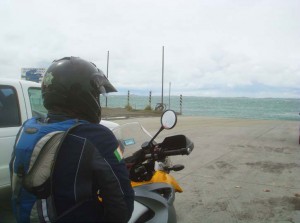 The bulkhead, which is two metres high, was immediately to our left and we parked the bikes on their side stands.
The bulkhead, which is two metres high, was immediately to our left and we parked the bikes on their side stands.
I offer to stay with the bikes while Maeve goes to pay the ferryman, but she’s having none of it! Not being too fond of boats she’s not moving until we get off.
So I go up the steps to the bridge where I meet the conductor and pay the fee. The view from up here is stunning. White horses race across the Strait and the horizon tilts from side to side and up and down as the swell tosses the craft about.
I get my tickets and turn around in time to see a giant wave break over the bow of the boat and crash down onto Maeve and the bikes. She had positioned herself to counter the swell by sitting side-saddle on her own bike while holding onto the left hand guard on my bike. Luckily for us it’s worked and while the bikes are moving they have yet to fall over.
Thirty minutes later we got to the other side and no amount of seaweed on the ramp would keep us from riding off the ferry.
We were then treated to 35 kilometres of good road, Ruta 257, which then ended abruptly and we were back on the rough stuff. The surface, although gravel and compacted mud, is fairly OK, except in the corners where all the gravel builds up into a type of truck generated berm. We continue along this route, progressing slowly and trying to stay warm when suddenly the dark sky above us opens and beats us with large hailstones! We both pull over and wait for it to pass. The shower is fairly brief, and the sun starts to shine again immediately afterward. The road, however, has now become somewhat messy. What was hard compacted mud became wet and slippery.
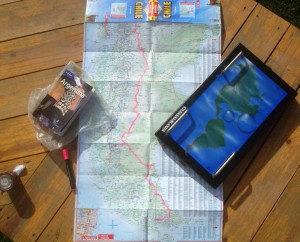 We’re now on the island of Tierra del Fuego, which literally translates as ‘The Land of Fire’. Apparently when the first Europeans arrived they found the native population actually carried small fires around with them!
We’re now on the island of Tierra del Fuego, which literally translates as ‘The Land of Fire’. Apparently when the first Europeans arrived they found the native population actually carried small fires around with them!
Our companions for the whole of our journey have been long distance truckers. In this part of the World the Mack and Kenilworth trucks of North America are replaced with the Scanias and Volvos that we are more familiar with in Europe, but they carry on with the same companionship and familiarity as anywhere else. Now as we ride along another dirt road in the snow and ice it seems to make sense. In the distance a big Mercedes tractor-trailer speeds towards us. Oncoming trucks are interesting, the nice guys would slow to almost a halt to let us pass, some didn’t slow up and sprayed us with mud and stones as they passed! We have adapted to the latter by slowing to a halt, placing both feet on the ground and leaning in behind the screen. The debris hits us but at least we don’t get it in the face. As the Merc is closing in I stop at the edge of the road and as I do so I hear the air breaks come on. The truck draws up beside me, the driver rolls down the window of his cab and sticks his head out, “¿hey amigo, este frio?” (“Hey buddy, this cold?) He smiles. “No, no, tengo mucho calor” (“No, no, I have plenty of heat). He howls with laughter at his own joke and drives on. I’m reminded of our trucking friend at the other end of our journey in Alaska asking if “We were having fun yet?” Trucker humour is obviously a global thing. However, someone has now noticed us on the road and passed the word on and now all the oncoming trucks flash their lights and the drivers’ wave at us. It’s strangely comforting, knowing that if something goes wrong in this desolate landscape, these guys are looking out for us.
Here on Tierra del Fuego the landscape is flat and the wind is unrelenting. There is little or no large vegetation, guanaco’s graze occasionally near the roadside and there is an abundance of sheep. Small crystal blue lakes play host to the most beautiful pink flamingos and occasionally an Antarctic fox and cubs pegs it across the road in front of the bikes.
We cross back onto Argentinean soil at San Sebastian, taking about twenty minutes at both border crossings – officials are polite, efficient and helpful. As we pull up to the Argentinean side of the border, a coach full of tourists gets there just ahead of us. Thankfully for us, the Policia keep a separate queue for coaches and a much shorter one for private vehicles. I meet a fellow Irishman, he’s has been travelling South America for seven months. On a coach!
Back into Argentina and we’re back on good roads. It’s just over 300 kilometres from here to Ushuaia, with a dreaded stretch of gravel road indicated on our map. Our first big town is Rio Grande and here we get a little lost, but a kind lady in a little Fiat Punto escorted us back onto the right road and we continued to make good time.
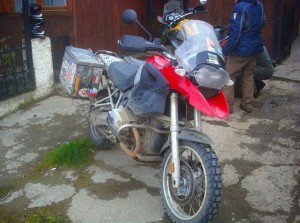 Fellow travellers warned us that Argentinean drivers can be a little aggressive. To be honest, we didn’t notice too much of a change from Chile, perhaps a little more corner cutting here than we were used to, but nothing too dramatic. Tierra del Fuego is a little like Aranmore Island in the west of Ireland. People are a little different to the “mainlanders”! Everyone here seems to drive much faster, overtakes a little more enthusiastically and generally seems to be more erratic. The two of us blended right in!
Fellow travellers warned us that Argentinean drivers can be a little aggressive. To be honest, we didn’t notice too much of a change from Chile, perhaps a little more corner cutting here than we were used to, but nothing too dramatic. Tierra del Fuego is a little like Aranmore Island in the west of Ireland. People are a little different to the “mainlanders”! Everyone here seems to drive much faster, overtakes a little more enthusiastically and generally seems to be more erratic. The two of us blended right in!
We refuelled in Tolhuin, and went into the small café at the petrol station try and get some heat into our cold bones before setting out on the last leg of the day’s journey. I turned around to look out at the bikes and could barely see them for snow – an instant blizzard! We waited a little until it died down and continued on our way. South of the town the scenery started to change dramatically. Huge lakes and steep snow covered mountains appeared before us. We waited anxiously for the dreaded gravel stretch of the road, but much to our delight it failed to materialize. A beautiful newly paved road led us up to the Paso Garibaldi, through the snow and wind and gave us amazing view of Lago Fagnano behind us. The snow made the road slippery so we slowed our pace until we descended again on the other side.
Then suddenly that sign was in front of our eyes, “Welcome to Ushuaia, the Southernmost City in the World”. We’d seen it in so many photographs, and now we were finally here ourselves, cold and tired but ecstatic. We made it, all the way from the top to the bottom, Deadhorse to Ushuaia! Incredible!
For our time in Ushuaia we’ve booked ourselves into a guest house with Francis and Alexandro.
We arrived here cold, hungry and very tired. When we told them that we had spent the previous seven months ridding our motorcycles from Alaska, Francis insisted on opening a fine bottle of red wine and cooking us dinner to celebrate our achievement. So here we were at the end of the world eating cannelloni and listening to tales of their travels in Europe and swapping stories about the remarkable similarities between southern Argentina and Canada.
Francis tells a tale of travelling to Scotland and going “tatty hokin” on a farm. Francis and Maeve have a good laugh at this while Alexandro and I try to figure what the hell they’re talking about. ‘Tatty hokin’ is Northern Irish and Scottish slang for picking potatoes apparently, and both Maeve and Francis have spent summer holidays earning pocket money doing this gad awful back breaking work.
One of the strange things of being on the road is how you meet people who are the very personification of the milk of human kindness and this couple are exactly that!
For the end our journey we couldn’t have met nicer people or stayed in a nicer house – muchas gracias amigos!
For now we need to sleep, tomorrow we’ve got to repair some minor damage on Maeve’s bike and we’ve got a lot of laundry to do…
Paul Browne
www.pabloscafe.ie



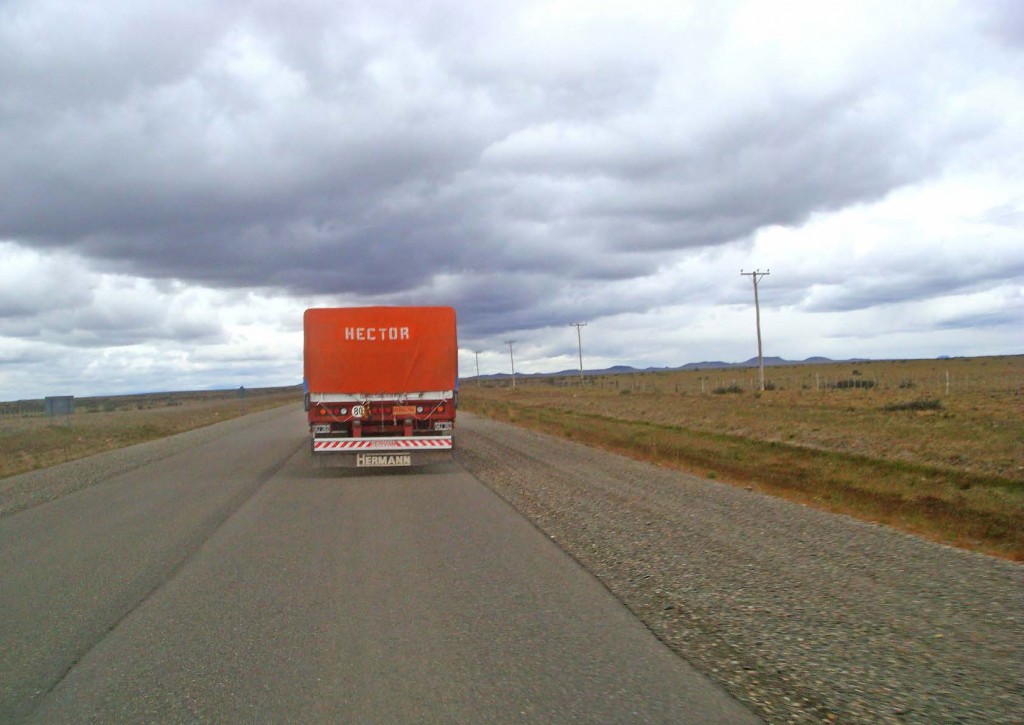




Good on the both of you for a great trip and the blog along with it. I had a 650 GS, shipped it to New Zealand for a bit then over to OZ and Tazie. Back to California then up to Alaska back over to the Yukon heading for Newfoundland. Bad luck and laid the bike down in the Yukon, end of trip, bike and fracture.
Its people like you that just make it so worth while to hear how you made the trip and the adventures as you traveled.
Where are you all off to next????